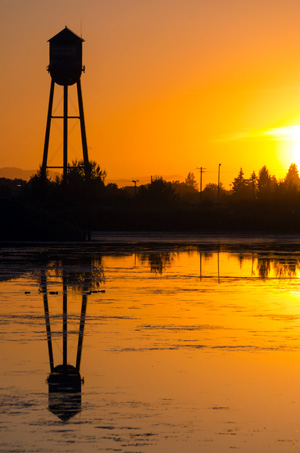 Sunset at Cheadle Lake in Lebanon. (Oregon State Archives Photo)
Sunset at Cheadle Lake in Lebanon. (Oregon State Archives Photo)
Source: Employment Department, Workforce and Economic Research Division
In spring 2020, the pandemic recession brought unparalleled job losses to Oregon. One out of seven jobs were lost in two months’ time. Unemployment hit a record high rate of 13.3% in April 2020. Oregon had never seen job losses at that scale and speed.
Two years after employment hit its recessionary bottom, Oregon experienced a remarkable rebound. Oregon employers added 123,500 jobs back by the end of 2020, and another 98,500 in calendar year 2021. Strong job gains continued into the early months of 2022. By April 2022, we had regained about nine out of 10 jobs that were lost in the pandemic recession. Prior to the pandemic recession, it took nearly six years (69 months) to add as many jobs (248,000) as in the two years since April 2020.
While all sectors initially experienced job losses, the pandemic recession hit service-providing industries the hardest, including leisure and hospitality, education and other services. The jobs recovery since spring 2020 has been uneven too. Widespread gains across several sectors pushed employment to new highs in many areas of Oregon’s economy. Meanwhile, other sectors lag behind, struggling to add back jobs.
By spring 2022, several sectors recovered their recession losses and expanded to new highs. For a variety of reasons, these sectors experienced smaller job losses than the overall economy and bounced back faster during the recovery. They included construction; wholesale trade; real estate and rental and leasing; the information sector; professional and technical services; and transportation, warehousing and utilities.
The sectors leading recovery have homes and residences as a common thread: greater likelihood to be working from them, building them, or making deliveries to them. In addition to all this, economic recovery from the pandemic recession has also been marked by strong demand and rapidly rising prices for homes themselves. Amid these dynamics, the real estate and rental and leasing industry reached new employment highs in spring 2022.
The hard-hit service sectors in the pandemic recession are also among those lagging in recovery. Leisure and hospitality lost 112,100 jobs in spring 2020, more than half (52%) of the sector’s total employment. Oregon’s hotels, restaurants, bars, and entertainment places added back 92,300 jobs by April 2022, and regained 82% of recession job losses. Yet leisure and hospitality remained 19,800 jobs below its pre-recession employment level. That was the largest job recovery deficit of any sector.
The education services sector in Oregon has also lagged in its jobs recovery. One part of that could be timing. Most schools were shuttered—either partially or fully—from at least spring 2020 through late summer 2021. That effectively made education the last sector to fully re-open in Oregon.
Public K–12, community colleges and public universities make up about half of all jobs in Oregon’s local government sector. During summer 2021, job gains rose sharply as enrichment programs picked up, and education institutions made fewer seasonal summer layoffs. The summer gains were not sustained. Public education fell short of typical hiring levels as the 2021–2022 academic year got underway, and employment levels changed little into 2022.
Private education services includes both privately owned K–12 and higher education institutions. They lost 8,100 jobs (-22%) in the pandemic recession. By April 2022, they regained 5,700 (or 70%) of those losses.
Oregon's Top 10 Agriculture Commodities in 2021
(Sources: USDA NASS in collaboration with the Oregon State Statistician, Oregon Department of Agriculture, Oregon State University, Oregon Department of Fish and Wildlife, and the Oregon Wine Board)